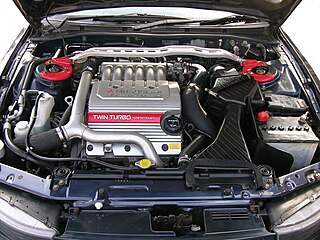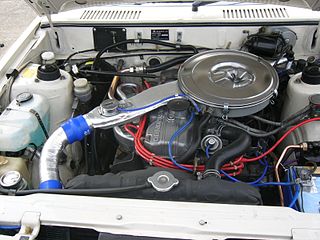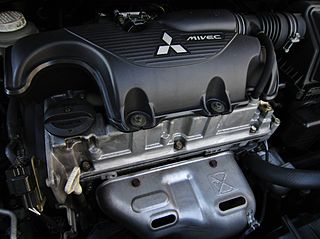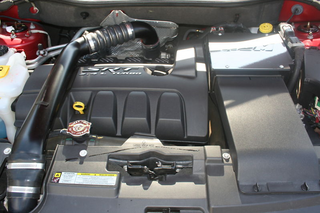
The Mitsubishi 6A1 engine is a series of piston V6 engines from Mitsubishi Motors, found in their small and medium vehicles through the 1990s. They ranged from 1.6 to 2.5 L in size, and came with a variety of induction methods and cylinder head designs and configurations.

The Mitsubishi Astron or 4G5/4D5 engine, is a series of straight-four internal combustion engines first built by Mitsubishi Motors in 1972. Engine displacement ranged from 1.8 to 2.6 litres, making it one of the largest four-cylinder engines of its time.

The Mitsubishi Sirius or 4G6/4D6 engine is the name of one of Mitsubishi Motors' four series of inline-four automobile engines, along with Astron, Orion, and Saturn.

The Mitsubishi Orion or 4G1 engine is a series of inline-four internal combustion engines introduced by Mitsubishi Motors in around 1977, along with the Astron, Sirius, and Saturn. It was first introduced in the Colt and Colt-derived models in 1978. Displacement ranges from 1.2 to 1.6 L.

The Mitsubishi 4G9 engine is a series of straight-4 automobile engines produced by Mitsubishi Motors. All are 16-valve, and use both single- and double- overhead camshaft heads. Some feature MIVEC variable valve timing, and it was the first modern gasoline direct injection engine upon its introduction in August 1996.

The 6G7 series or Cyclone V6 engine is a series of V6 piston engines from Mitsubishi Motors. Five displacement variants were produced from 1986 to 2021, with both SOHC and DOHC, naturally aspirated and turbo charged layouts. While MIVEC variable valve timing has also been implemented in some versions the 2.5, 3.0 and 3.5 L versions were also available with gasoline direct injection. This engine has been the flagship powerplant of the company except when they briefly built a V8 in 1999–2001. The staple of their high-end sedans, it was given twin-turbos for the Mitsubishi GTO, and became the most powerful car ever built by the company at the time.

The E-series was a line of inline four-cylinder automobile engines designed and built by Honda for use in their cars in the 1970s and 1980s. These engines were notable for the use of CVCC technology, introduced in the ED1 engine in the 1975 Civic, which met 1970s emissions standards without using a catalytic converter.

The J-series is Honda's fourth production V6 engine family introduced in 1996, after the C-series, which consisted of three dissimilar versions. The J-series engine was designed in the United States by Honda engineers. It is built at Honda's Anna, Ohio, and Lincoln, Alabama, engine plants.

The Honda D series inline-four cylinder engine is used in a variety of compact models, most commonly the Honda Civic, CRX, Logo, Stream, and first-generation Integra. Engine displacement ranges between 1.2 and 1.7 liters. The D Series engine is either SOHC or DOHC, and might include VTEC variable valve timing. Power ranges from 66 PS (49 kW) in the Logo to 130 PS (96 kW) in the Civic Si. D-series production commenced 1984 and ended 2005. D-series engine technology culminated with production of the D15B 3-stage VTEC (D15Z7) which was available in markets outside of the United States. Earlier versions of this engine also used a single port fuel injection system Honda called PGM-CARB, signifying the carburetor was computer controlled.

The Suzuki G engine is a series of three- and four-cylinder internal combustion engines manufactured by Suzuki Motor Corporation for various automobiles, primarily based on the GM M platform, as well as many small trucks such as the Suzuki Samurai and Suzuki Vitara and their derivatives.
The Honda F-Series engine was considered Honda's "big block" SOHC inline four, though lower production DOHC versions of the F-series were built. It features a solid iron or aluminum open deck cast iron sleeved block and aluminum/magnesium cylinder head.

The L-series is a compact inline-four engine created by Honda, introduced in 2001 with the Honda Fit. It has 1.2 L (1,198 cc), 1.3 L (1,318 cc) and 1.5 litres (1,497 cc) displacement variants, which utilize the names L12A, L13A and L15A. Depending on the region, these engines are sold throughout the world in the 5-door Honda Brio Fit/Jazz hatchback Honda Civic and the 4-door Fit Aria/City sedan. They are also sold in the Japanese-only Airwave wagon and Mobilio MPV.

The Honda R engine is an inline-four engine launched in 2006 for the Honda Civic (non-Si). It is fuel injected, has an aluminum-alloy cylinder block and cylinder head, is a SOHC 16-valve design and utilizes Honda's i-VTEC system. The R series engine has a compression ratio of 10.5:1, features a "drive by wire" throttle system which is computer controlled to reduce pumping losses and create a smooth torque curve.
The Mitsubishi 4M4 engine is a range of four-cylinder diesel piston engines from Mitsubishi Motors, first introduced in the second generation of their Montero/Pajero/Shogun SUVs. They superseded the previous 4D5 engine family, main differences are enlarged displacements and the utilization of one or two over-head camshafts. Originally available only as a 2835 cc intercooled turbo, detail improvements in 1996 and a larger 3.2 litre option in 1999 served to improve power, torque, fuel economy and emissions. The final version has 3.0 litres swept volume and Common rail direct injection.

The Honda G-series engine is a family of slanted inline-five cylinder gasoline engines; the engines are SOHC with 4 valves per cylinder. They were originally used in the 1989 Honda Vigor, Honda Rafaga, Honda Ascot and Honda Inspire. They carried over to the Vigor's successor the Acura 2.5TL, which ran from 1995-1998 in North America, and the Honda Saber in Japan.

The Mitsubishi 4A3 engine is a range of alloy-headed inline four-cylinder engines from Mitsubishi Motors, introduced in 1993 in the sixth generation of their Mitsubishi Minica kei car. It shares a 72 mm (2.8 in) bore pitch with the 3G8-series three-cylinder engines, but has a considerably shorter stroke so as to stay beneath the 660 cc limit imposed by the Kei class.

The Honda P engine is an inline three-cylinder gasoline engine first designed for use in Honda kei cars. The P engine was first used in the fourth generation Honda Life, as a successor to the Honda E07A engine. The P engine series was initially produced in only one displacement variant: 658 cc, either naturally aspirated or turbocharged. A turbocharged one-litre version, the P10A, has since been developed. The smaller version was discontinued in December 2013, when it was replaced by the new S07 series engine, but the P10A continues to be built in Thailand.

The E0 series is a three-cylinder gasoline engine developed and manufactured by Honda, with a total displacement of 656 cc. The engine is intended for kei car applications. The E05A and E07A were partially replaced by the Honda P engine but as of 2020 the E07Z engine still saw use in the Acty truck.

The World Gasoline Engine is a family of straight-4 piston engines, based on the Global Engine Alliance design.

The Suzuki K engine family is a series of all aluminium inline-three or four cylinder automobile engines from Suzuki, introduced in 1994. The displacement is ranging from 0.7 L to 1.5 L. This is a timing chain head driven DOHC 4-valve per cylinder engine with VVT and using multipoint fuel injection or direct injection fuel system.



















